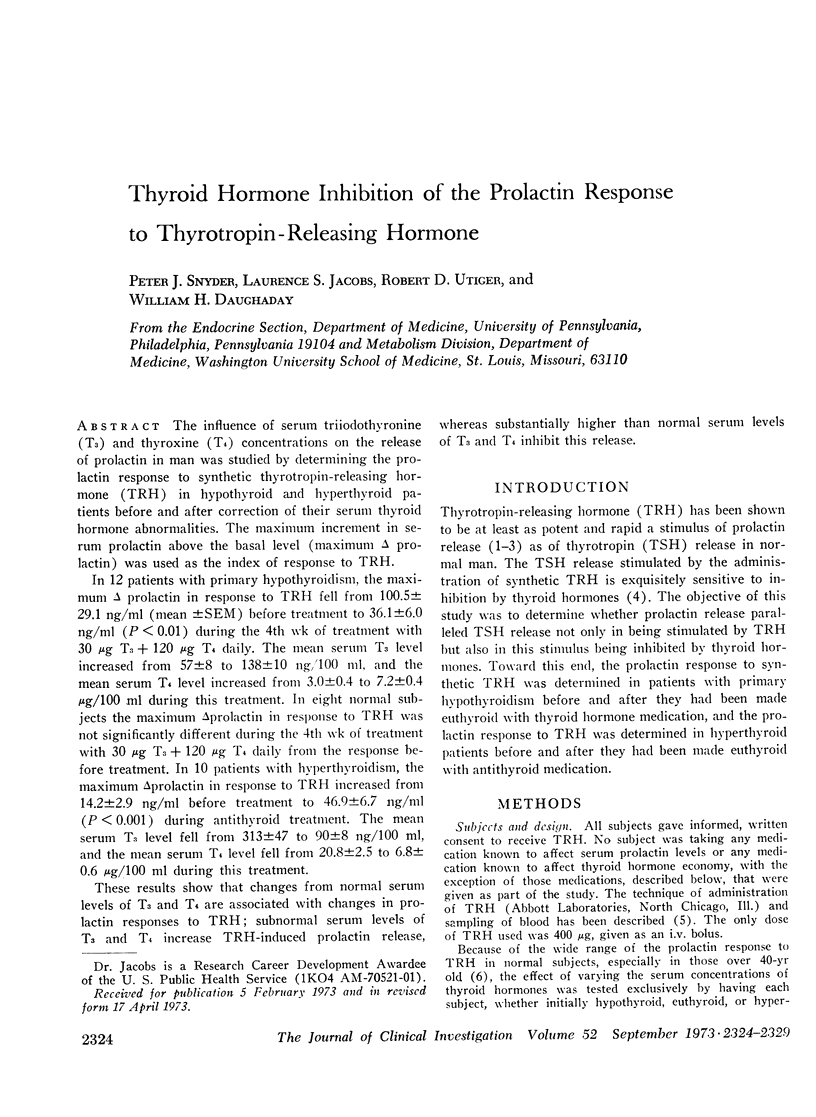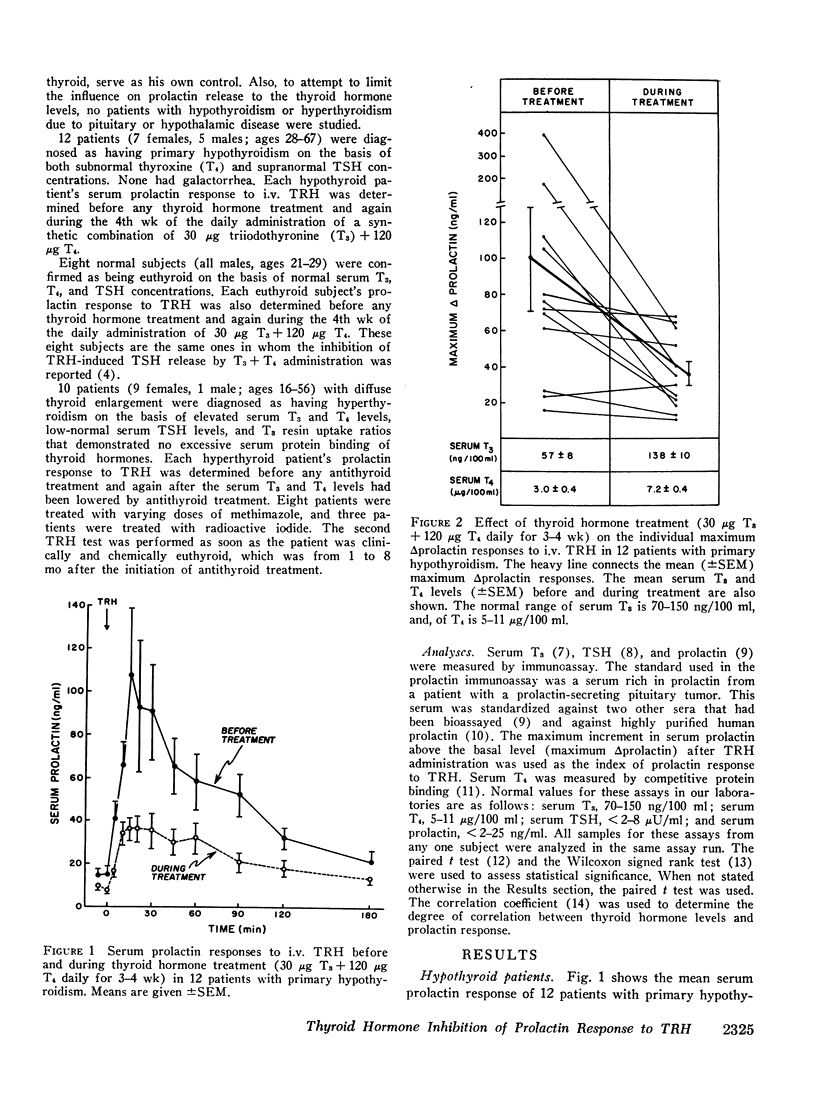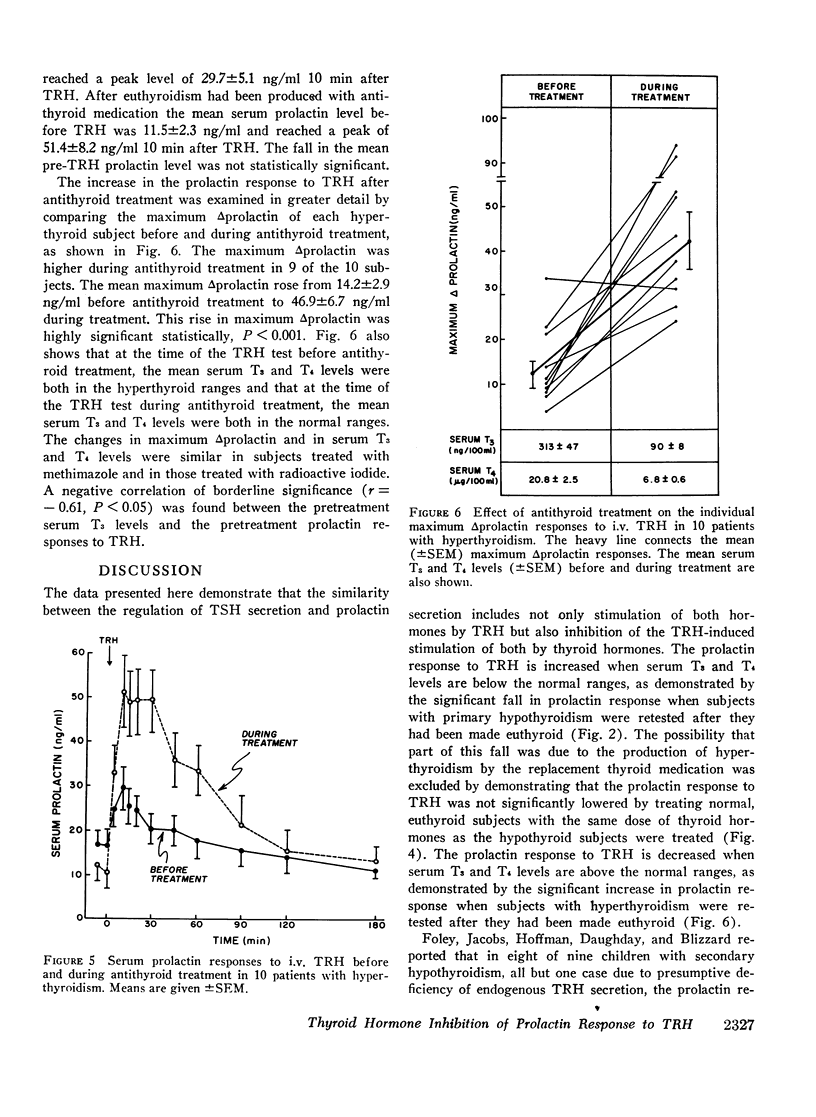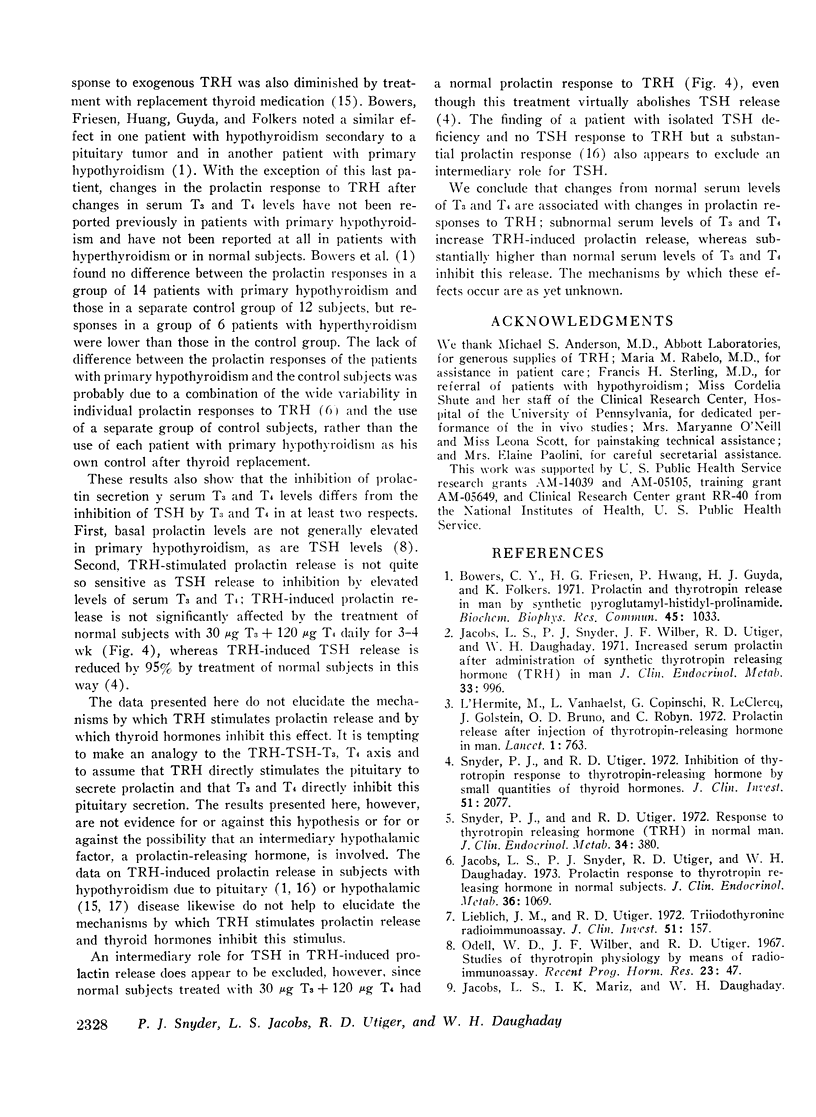Abstract
The influence of serum triiodothyronine (T3) and thyroxine (T4) concentrations on the release of prolactin in man was studied by determining the prolactin response to synthetic thyrotropin-releasing hormone (TRH) in hypothyroid and hyperthyroid patients before and after correction of their serum thyroid hormone abnormalities. The maximum increment in serum prolactin above the basal level (maximum Δ prolactin) was used as the index of response to TRH.
In 12 patients with primary hypothyroidism, the maximum Δ prolactin in response to TRH fell from 100.5±29.1 ng/ml (mean ±SEM) before treatment to 36.1±6.0 ng/ml (P < 0.01) during the 4th wk of treatment with 30 μg T3 + 120 μg T4 daily. The mean serum T3 level increased from 57±8 to 138±10 ng/100 ml, and the mean serum T4 level increased from 3.0±0.4 to 7.2±0.4 μg/100 ml during this treatment. In eight normal subjects the maximum Δprolactin in response to TRH was not significantly different during the 4th wk of treatment with 30 μg T3 + 120 μg T4 daily from the response before treatment. In 10 patients with hyperthyroidism, the maximum Δprolactin in response to TRH increased from 14.2±2.9 ng/ml before treatment to 46.9±6.7 ng/ml (P < 0.001) during antithyroid treatment. The mean serum T3 level fell from 313±47 to 90±8 ng/100 ml, and the mean serum T4 level fell from 20.8±2.5 to 6.8±0.6 μg/100 ml during this treatment.
These results show that changes from normal serum levels of T3 and T4 are associated with changes in prolactin responses to TRH; subnormal serum levels of T3 and T4 increase TRH-induced prolactin release, whereas substantially higher than normal serum levels of T3 and T4 inhibit this release.
Full text
PDF





Selected References
These references are in PubMed. This may not be the complete list of references from this article.
- Bowers C. Y., Friesen H. G., Hwang P., Guyda H. J., Folkers K. Prolactin and thyrotropin release in man by synthetic pyroglutamyl-histidyl-prolinamide. Biochem Biophys Res Commun. 1971 Nov;45(4):1033–1041. doi: 10.1016/0006-291x(71)90441-4. [DOI] [PubMed] [Google Scholar]
- Foley T. P., Jr, Jacobs L. S., Hoffman W., Daughaday W. H., Blizzard R. M. Human prolactin and thyrotropin concentrations in the serums of normal and hypopituitary children before and after the administration of synthetic thyrotropin-releasing hormone. J Clin Invest. 1972 Aug;51(8):2143–2150. doi: 10.1172/JCI107021. [DOI] [PMC free article] [PubMed] [Google Scholar]
- Jacobs L. S., Mariz I. K., Daughaday W. H. A mixed heterologous radioimmunoassay for human prolactin. J Clin Endocrinol Metab. 1972 Mar;34(3):484–490. doi: 10.1210/jcem-34-3-484. [DOI] [PubMed] [Google Scholar]
- Jacobs L. S., Snyder P. J., Utiger R. D., Daughaday W. H. Prolactin response to thyrotropin releasing hormone in normal subjects. J Clin Endocrinol Metab. 1973 Jun;36(6):1069–1073. doi: 10.1210/jcem-36-6-1069. [DOI] [PubMed] [Google Scholar]
- Jacobs L. S., Snyder P. J., Wilber J. F., Utiger R. D., Daughaday W. H. Increased serum prolactin after administration of synthetic thyrotropin releasing hormone (TRH) in man. J Clin Endocrinol Metab. 1971 Dec;33(6):996–998. doi: 10.1210/jcem-33-6-996. [DOI] [PubMed] [Google Scholar]
- Kaplan S. L., Grumbach M. M., Friesen H. G., Costom B. H. Thyrotropin releasing factor (TRF) effect on secretion of human pituitary prolactin and thyrotropin in children and in idiopathic hypopituitary dwarfism: further evidence for hypophysiotropic hormone deficiencies. J Clin Endocrinol Metab. 1972 Dec;35(6):825–830. doi: 10.1210/jcem-35-6-825. [DOI] [PubMed] [Google Scholar]
- L'Hermite M., Copinschi G., Golstein J., Vanhaelst L., Leclercq R., Bruno O. D. Prolactin release after injection of thyrotrophin-releasing hormone in man. Lancet. 1972 Apr 8;1(7754):763–765. doi: 10.1016/s0140-6736(72)90519-3. [DOI] [PubMed] [Google Scholar]
- Lewis U. J., Singh R. N., Seavey B. K. Human prolactin: isolation and some properties. Biochem Biophys Res Commun. 1971 Sep;44(5):1169–1176. doi: 10.1016/s0006-291x(71)80209-7. [DOI] [PubMed] [Google Scholar]
- Lieblich J., Utiger R. D. Triiodothyronine radioimmunoassay. J Clin Invest. 1972 Jan;51(1):157–166. doi: 10.1172/JCI106786. [DOI] [PMC free article] [PubMed] [Google Scholar]
- MURPHY B. E., PATTEE C. J. DETERMINATION OF THYROXINE UTILIZING THE PROPERTY OF PROTEIN-BINDING. J Clin Endocrinol Metab. 1964 Feb;24:187–196. doi: 10.1210/jcem-24-2-187. [DOI] [PubMed] [Google Scholar]
- Sachson R., Rosen S. W., Cuatrecasas P., Roth J., Frantz A. G. Prolactin stimulation by thyrotropin-releasing hormone in a patient with isolated thyrotropin deficiency. N Engl J Med. 1972 Nov 9;287(19):972–973. doi: 10.1056/NEJM197211092871909. [DOI] [PubMed] [Google Scholar]
- Snyder P. J., Utiger R. D. Inhibition of thyrotropin response to thyrotropin-releasing hormone by small quantities of thyroid hormones. J Clin Invest. 1972 Aug;51(8):2077–2084. doi: 10.1172/JCI107014. [DOI] [PMC free article] [PubMed] [Google Scholar]
- Snyder P. J., Utiger R. D. Response to thyrotropin releasing hormone (TRH) in normal man. J Clin Endocrinol Metab. 1972 Feb;34(2):380–385. doi: 10.1210/jcem-34-2-380. [DOI] [PubMed] [Google Scholar]


